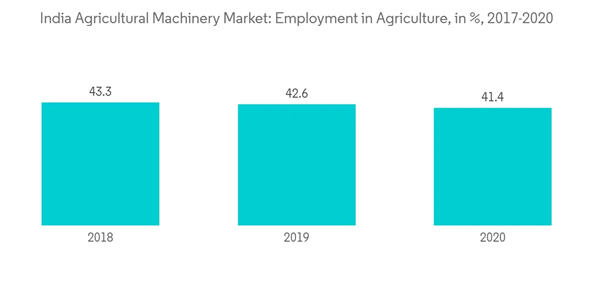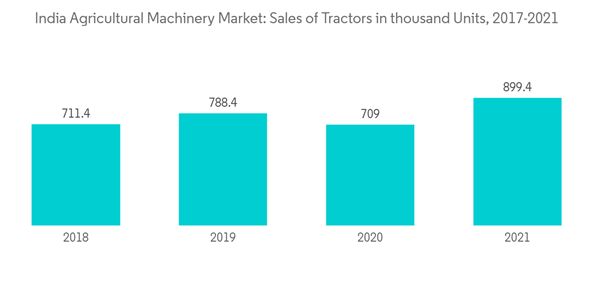Key Highlights
- The potential for growth in the agriculture machinery sector is enormous in India, given its growing population, high economic dependence on the agriculture sector, changing demographics, and food security concerns. In Asia-Pacific, India remained one of the primary nations, fuelling the growth of its agricultural equipment market due to its high dependence on agriculture and an increasing inclination toward technology adoption.
- Along with this, some major drivers of the Indian agricultural machinery market include favorable government policies, rising farm incomes, and the importance of mechanization for productivity in India. For instance, The Government of India launched a unique program called "Sub Mission on Agricultural Mechanization (SMAM)" in 2014-15 to increase farm mechanization across the nation. A total of INR 4556.93 crores (USD 554.9 million) in funds have been made available under the scheme to the States and other implementing institutions between 2014-15 and 2020-21. More than 27.5 thousand custom hiring institutions have been founded, and more than 13 lakh agricultural machines have been provided. The budget for SMAM increased from the prior year to INR 1050 crore (USD 127.7 million) for 2021-22.
- Furthermore, the country's unavailability and high labor wages are increasing the demand for agricultural machinery products. Also, agriculture mechanization is essential because it helps increase crops' productivity by increasing the effectiveness and efficiency of the inputs used in crop production. It lessens the laboriousness involved in numerous farm tasks, thereby attracting farmers with modern techniques and advanced farm machinery for improved yield. These factors are supporting the growth of the agricultural machinery market in the country.
India Agricultural Machinery Market Trends
Increasing Focus on Farm Mechanization
In India, about half the population relies on agriculture as it is the principal source of income and raw materials for many industries. The increase in the production of grains, cereals, and oilseeds created the need and demand for modern farm equipment as it requires heavy harvesting operations, reducing wastage and improving yield. For instance, according to the Ministry of Agriculture and Farmers Welfare (India), more than 288 million MT of cereals were estimated to be produced in India at the end of the financial year 2022. These cereals include rice, wheat, barley, millet, and ragi. This South Asian country was the world's second-largest producer of rice and wheat. Thus, the increased farming operation to maintain the yield pushes the farmers towards farm mechanization.Additionally, there is a constant shortage of labor-intensive agricultural operations in India due to the changing workforce preference from pure farm-oriented activities to allied sectors. Rapid urbanization is also one of the primary reasons for the increase in farm mechanization, as the workforce in agriculture is decreasing and moving to urban areas. For instance, according to World Bank data, the percentage of people employed decreased for several years. In 2017 the percentage of people employed in agriculture was 44% which fell to 41.4% in 2020. Thus, the labor shortage is anticipated to drive and increase the demand for farm equipment over the coming years.
Along with this, another factor driving farm mechanization in the country is the struggle of farm activities, as the timely performance of farm activities and the small window for conducting these operations compound the challenges. Thus, the need to increase production and cater to a consistent shortage in the labor force is increasing the focus on farm mechanization during the forecast period.
Tractor Segment to Drive the Indian Agricultural Machinery Market
India is one of the largest markets for tractors in the world as they form the majority of machinery usage in India. Tractors are engines or vehicles for pulling wagons or plows. In India, tractors are also used for drawing, towing, harrowing, and other than plowing. The usage of tractors brought about an essential change in agricultural mechanization in the country, as the automation provided by tractors plays a crucial role in increasing agricultural productivity. Additionally, due to the shortage of farm labor and the growth of novel business models, such as tailored tractor hiring services, India continues to be a very profitable market for tractors. In India, many farmers employ tractors for their agricultural operations. For instance, KhetiGaadi is a business that rents out many tractors. Farmers can choose among the several tractors offered on KhetiGaadi for rental purposes. It helps farmers to use the agricultural equipment on their farms by renting and reducing the high investments.Along with this, the country produces a massive volume of tractors and also exports tractors globally. According to the Indian government, compared to the same period in 2013, India's tractor exports increased by more than 72%, reaching USD 1025 million from April to December 2021. The primary destination for the export of tractors is the US (25.2%), Nepal (7.3%), Bangladesh (6.5%), Thailand (5.4%) & Sri Lanka (5.3 %). Also, the production and sales of significant players in the Indian market are growing, which directly indicates that the tractor market in India is growing. For instance, in India, in February 2022, Mahindra's Farm Equipment Sector sold 18,910 units. February 2022 saw 20,437 tractor sales (domestic + exports), compared to 28,146 units during the same month last year. Additionally, the overall sales of tractors in India are also increasing for several years. For instance, according to the Federation Of Automobile Dealers Association, the sales of tractors increased from 581.5 thousand units to 899.4 thousand units in 2021.
The increasing farm mechanization, coupled with the rising farmers' need due to the lack of labor and cost-effective solutions like rentals, and financial assistance from the Indian government through various schemes, such as the Remunerative Approach for Agriculture and Allied Sector Rejuvenation (RKVY), National Food Security Mission (NFSM), National Mission on Oilseeds and Oil Palm (NHM & NMOOP), will likely accelerate tractor sales over the coming years. It shows the increase in farm mechanization in the country.
India Agricultural Machinery Industry Overview
The Indian agricultural machinery market is consolidated, with the significant players occupying the maximum share of the market. Renowned players like Mahindra & Mahindra Ltd, CNH Industrial NV, Tractors and Farm Equipment Ltd, Escorts Group, and Sonalika are significant players in the Indian agricultural machinery market. New product launches, partnerships, and acquisitions are the major strategies that leading companies adopt.Additional Benefits:
- The market estimate (ME) sheet in Excel format
- 3 months of analyst support
This product will be delivered within 2 business days.
Table of Contents
Companies Mentioned (Partial List)
A selection of companies mentioned in this report includes, but is not limited to:
- John Deere India Private Limited
- TAFE Motors and Tractors Limited
- International Tractors Ltd (Sonalika)
- Escorts Limited
- Mahindra & Mahindra Limited
- CNH Industrial (India) Private Limited
- Force Motors Ltd
- VST Tillers Tractors Limited
- Shivagrico Implements Limited
- Greaves Cotton Limited










